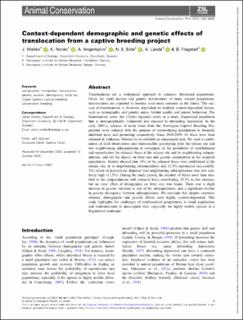Context-dependent demographic and genetic effects of translocation from a captive breeding project
Wallen, Johan; Norén, Karin; Angerbjörn, Anders; Eide, Nina Elisabeth; Landa, Arild; Flagstad, Øystein
Peer reviewed, Journal article
Published version

Åpne
Permanent lenke
https://hdl.handle.net/11250/3033463Utgivelsesdato
2022Metadata
Vis full innførselSamlinger
- Publikasjoner fra CRIStin - NINA [2364]
- Scientific publications [1392]
Originalversjon
10.1111/acv.12831Sammendrag
Translocations are a widespread approach to conserve threatened populations. Given the rapid decline and genetic deterioration of many natural populations, translocations are expected to become even more common in the future. The success of translocations is, however, dependent on multiple context-dependent factors, such as demographic and genetic status, habitat quality and animal behaviour. The Scandinavian arctic fox (Vulpes lagopus) exists in a small, fragmented population that is demographically vulnerable and exposed to inbreeding depression. In the early 2000 s, releases of arctic foxes from the Norwegian Captive Breeding Programme were initiated with the purpose of reintroducing populations to formerly inhabited areas and promoting connectivity. Since 2008/2009, 61 foxes have been released in Junkeren, Norway to re-establish an unoccupied area. We used a combination of field observations and microsatellite genotyping from the release site and two neighbouring subpopulations to investigate (i) the probability of establishment and reproduction for released foxes at the release site and in neighbouring subpopulations, and (ii) the impact on litter size and genetic composition in the recipient populations. Results showed that 18% of the released foxes were established at the release site, or in neighbouring subpopulations and 11.5% reproduced successfully. The extent of post-release dispersal into neighbouring subpopulations was also relatively high (11.5%). During the study period, the number of litters more than doubled in the subpopulations with released foxes contributing 29.5% to this increase, but no clear effect of immigration on litter size was found. There was a slight increase in genetic variation in one of the subpopulations, and a significant decline in genetic divergence between subpopulations. We conclude that despite extensive releases, demographic and genetic effects were highly context-dependent. This study highlights the challenges of reinforcement programmes in small populations and reintroductions to unoccupied sites, especially for highly mobile species in a fragmented landscape. conservation; immigration; translocation; genetic variation; demography; arctic fox; Vulpes lagopus; captive breeding; conservation breeding.
